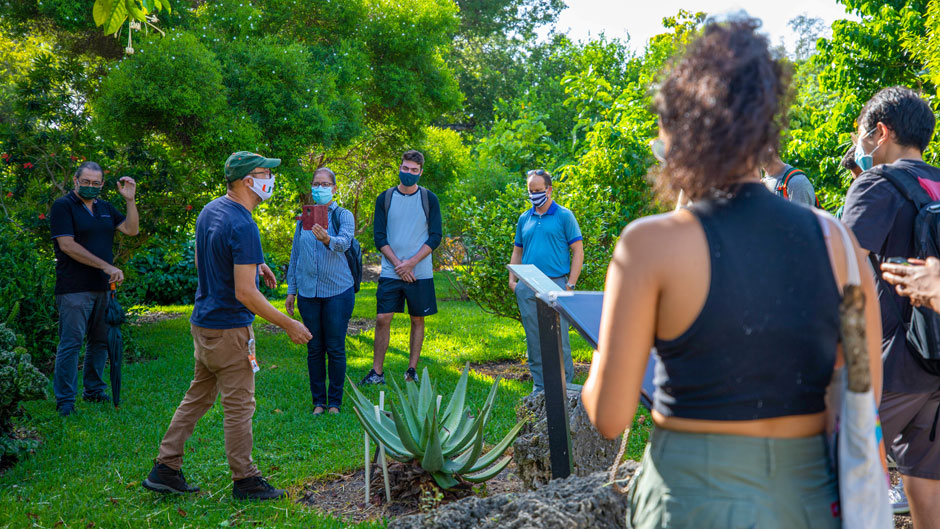Envision a wall filled with lush plants that could filter rainwater while simultaneously hydrating its inhabitants. And a few steps away, down a recycled rubber pathway, visitors to the tropical oasis could find benches with seats that also serve as solar panels, with outlets to power laptops or charge cell phones. Further along, they may encounter an outdoor pavilion able to be used as a classroom with a rooftop lounge for visitors to appreciate the surrounding greenery.
These are just a few of the ideas that senior engineering students offered to increase the visibility and use of the University of Miami John C. Gifford Arboretum. The students presented their ideas to campus stakeholders early this week during one of the final sessions of their capstone design class, led by faculty members Matthew Trussoni and Esber Andiroglu, both in the Department of Civil, Architectural, and Environmental Engineering in the College of Engineering. The presentations were the final step in a semester-long team building exercise that was introduced during a class tour of the arboretum in late August.
The impetus to solicit students’ ideas came last summer, when alumnus Eric D. Brueggeman generously offered to fund some improvements to the Gifford Arboretum in order to elevate its use. Both Andiroglu and Trussoni thought it was the perfect opportunity to have their students work together and use their skills from a range of engineering specialties to propose ideas for the arboretum.
“Often students come to the University and leave four years later without even going to the arboretum,” said Andiroglu, associate professor of professional practice.
A group of faculty and staff hope that in the future that will no longer be the case. The arboretum designs became the first major assignment for Trussoni and Andiroglu’s students, and the aspiring engineers spent the first three weeks of the semester working in cross-disciplinary teams to devise their proposals. They presented their pitches to a group that included Mauro Galetti, the arboretum’s director and biology associate professor; three members of the Faculty Senate committee on facilities and planning; Terri Hood, senior lecturer and assistant director for the undergraduate ecosystem science and policy program, who maintains the Sustainability Garden inside the arboretum; and Teddy L’Houtellier, the University’s sustainability manager. The group will now rank the students’ ideas and make recommendations about which are most feasible for the arboretum. Hopefully, some of the renovations will begin next semester, Galetti said.
Tucked behind the Knight Physics Building at the northwest corner of campus, the Gifford Arboretum holds close to 500 trees, including tropical and subtropical species, from six continents. It is free and open to the public and also contains many edible fruit trees, as well as the Sustainability Garden, where students grow plants and food as part of their classes.
Earlier this semester, as the students toured the arboretum with Galetti, he explained the need to add more solid pathways, so that physically disabled individuals can also enjoy the space. In addition, Galetti wants to add water fountains, additional seating, new signage, and some low-beam lighting. As they walked, Trussoni and Andiroglu, who are both sustainable design experts, encouraged the students to brainstorm. They also suggested that the teams design a social gathering space for engineering students, since the College of Engineering, which is nearby, does not offer one.
“You could offer outdoor pavilions that are ADA-compliant and use solar power,” Andiroglu suggested, reminding students to consider things like wind, shade, and storm water as key factors in their design. “It’s an open canvas.”
Students were inspired within minutes.
“I’ve always visited the arboretum, and I’ve noticed that not many people come and hang out here because there are no facilities. So, hopefully we can create something that people will see and actually get to enjoy in future years,” said Lutfiah Hammad, a senior environmental engineering major who hails from Saudi Arabia.
Montale Tuen, who is studying materials engineering, was also eager to start. “This is a great opportunity because what I study is mostly in the lab and therefore the skills are less applicable than construction, but having the opportunity to work on a project like this will force me to step out of the lab and confront new challenges, as well as to find more sustainable and environmentally friendly materials and methods,” he said.
This past Monday, five teams presented their ideas. Some included new entrance points leading into the arboretum, a small coffee shop just within the entrance similar to the Billy Goat Mobile Coffee Kiosk at the School of Architecture, a U-shaped “Hurricane Amphitheater” that could serve as a classroom and outdoor performance space, decorative fountains that would collect and filter water to irrigate plants and trees, and a bio retention pond, as well as a hand-pump drinking fountain.
“Our goal was to integrate new and exciting potential spaces to draw students in, while maintaining the integrity of the arboretum,” said Jake Vinci, a civil engineering student.
Trussoni, assistant professor of professional practice, said he liked some student ideas to offer multiple entry points with more appealing signage and thinks those minimal ideas will help increase foot traffic.
“Part of the issue is that the arboretum is located in the far reaches of campus, so any visual marker will help bring more people to enjoy the arboretum space,” he pointed out.
Galetti said he was impressed with the student proposals and that the committee will likely use a combination of ideas from different teams. And ideally, some of the students will volunteer in the arboretum next semester to make their proposals a reality.
“Our next step is to look at what we can use in each project to maximize the donor’s gift with the least impact possible to the tree collection and the peaceful atmosphere,” he said.

